Digital Marketing: Consumer Behavior and CRM Analysis Report
VerifiedAdded on 2020/05/11
|6
|1453
|65
Report
AI Summary
This report examines the transformative influence of digital technology on the retail industry and its impact on consumer behavior. It explores how digital marketing strategies, customer relationship management (CRM), and website design are crucial in attracting and retaining customers. The report analyzes the evolution of online shopping, the customer journey, and the integration of online and offline experiences. It highlights the importance of data in CRM and website design, emphasizing how organizations leverage data to understand customer behavior and optimize digital marketing performance. The report also discusses the advantages of digital marketing over traditional methods and how it enables businesses to reach a wider audience. Finally, it underscores the importance of seamless integration of web tools and the use of compelling content strategies to enhance customer loyalty.

Running head: DIGITAL MARKETING
Digital marketing
Name of the Student:
Name of the University:
Author’s Note:
Digital marketing
Name of the Student:
Name of the University:
Author’s Note:
Paraphrase This Document
Need a fresh take? Get an instant paraphrase of this document with our AI Paraphraser
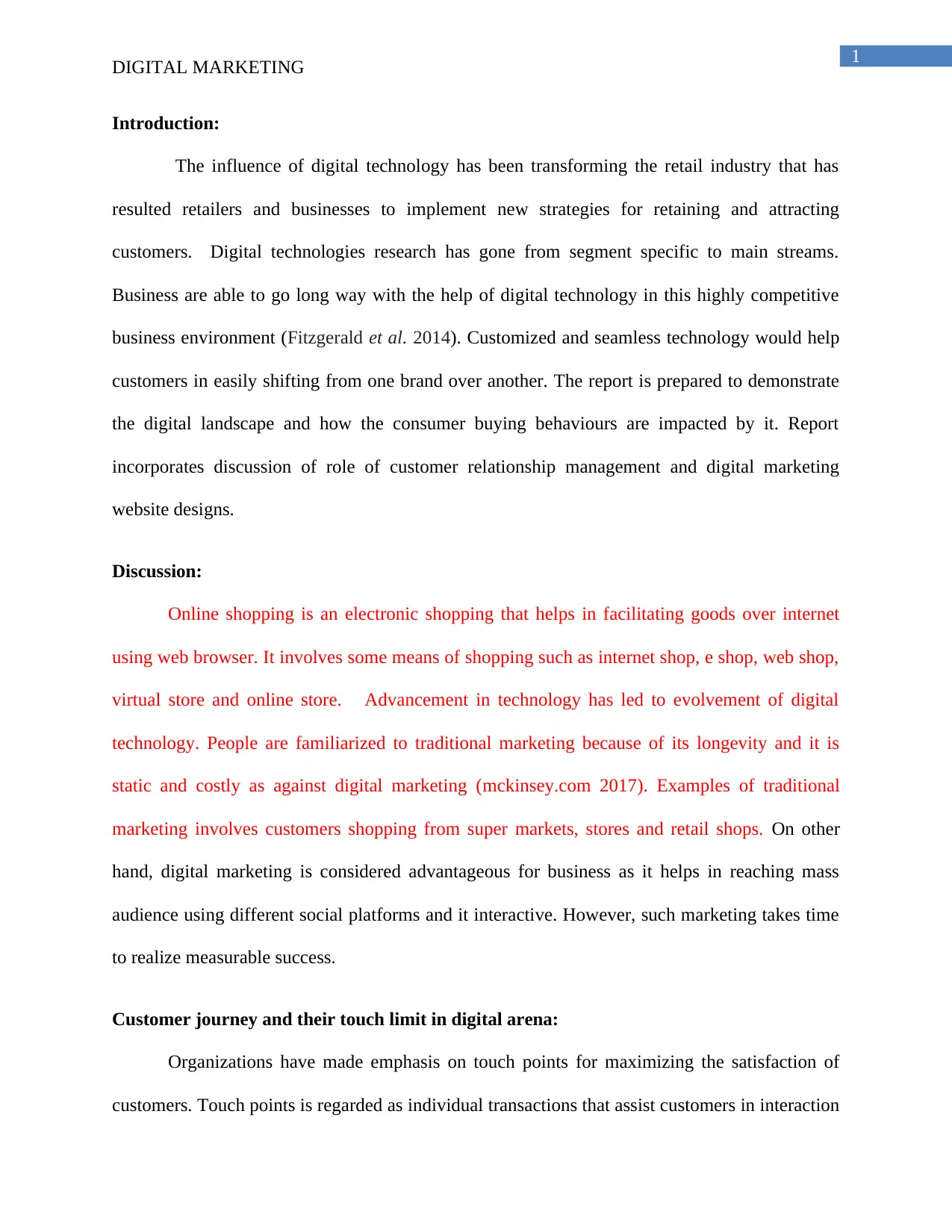
1
DIGITAL MARKETING
Introduction:
The influence of digital technology has been transforming the retail industry that has
resulted retailers and businesses to implement new strategies for retaining and attracting
customers. Digital technologies research has gone from segment specific to main streams.
Business are able to go long way with the help of digital technology in this highly competitive
business environment (Fitzgerald et al. 2014). Customized and seamless technology would help
customers in easily shifting from one brand over another. The report is prepared to demonstrate
the digital landscape and how the consumer buying behaviours are impacted by it. Report
incorporates discussion of role of customer relationship management and digital marketing
website designs.
Discussion:
Online shopping is an electronic shopping that helps in facilitating goods over internet
using web browser. It involves some means of shopping such as internet shop, e shop, web shop,
virtual store and online store. Advancement in technology has led to evolvement of digital
technology. People are familiarized to traditional marketing because of its longevity and it is
static and costly as against digital marketing (mckinsey.com 2017). Examples of traditional
marketing involves customers shopping from super markets, stores and retail shops. On other
hand, digital marketing is considered advantageous for business as it helps in reaching mass
audience using different social platforms and it interactive. However, such marketing takes time
to realize measurable success.
Customer journey and their touch limit in digital arena:
Organizations have made emphasis on touch points for maximizing the satisfaction of
customers. Touch points is regarded as individual transactions that assist customers in interaction
DIGITAL MARKETING
Introduction:
The influence of digital technology has been transforming the retail industry that has
resulted retailers and businesses to implement new strategies for retaining and attracting
customers. Digital technologies research has gone from segment specific to main streams.
Business are able to go long way with the help of digital technology in this highly competitive
business environment (Fitzgerald et al. 2014). Customized and seamless technology would help
customers in easily shifting from one brand over another. The report is prepared to demonstrate
the digital landscape and how the consumer buying behaviours are impacted by it. Report
incorporates discussion of role of customer relationship management and digital marketing
website designs.
Discussion:
Online shopping is an electronic shopping that helps in facilitating goods over internet
using web browser. It involves some means of shopping such as internet shop, e shop, web shop,
virtual store and online store. Advancement in technology has led to evolvement of digital
technology. People are familiarized to traditional marketing because of its longevity and it is
static and costly as against digital marketing (mckinsey.com 2017). Examples of traditional
marketing involves customers shopping from super markets, stores and retail shops. On other
hand, digital marketing is considered advantageous for business as it helps in reaching mass
audience using different social platforms and it interactive. However, such marketing takes time
to realize measurable success.
Customer journey and their touch limit in digital arena:
Organizations have made emphasis on touch points for maximizing the satisfaction of
customers. Touch points is regarded as individual transactions that assist customers in interaction
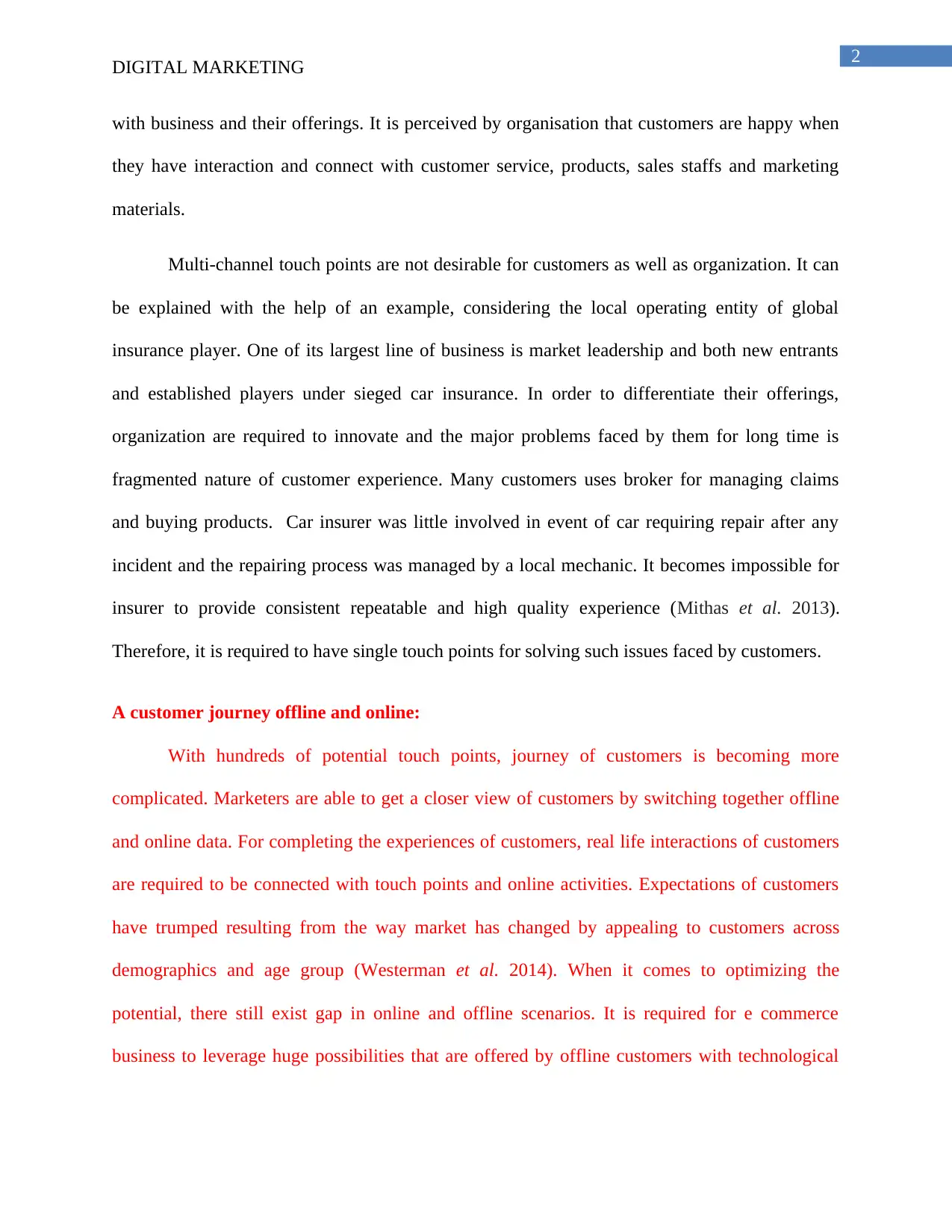
2
DIGITAL MARKETING
with business and their offerings. It is perceived by organisation that customers are happy when
they have interaction and connect with customer service, products, sales staffs and marketing
materials.
Multi-channel touch points are not desirable for customers as well as organization. It can
be explained with the help of an example, considering the local operating entity of global
insurance player. One of its largest line of business is market leadership and both new entrants
and established players under sieged car insurance. In order to differentiate their offerings,
organization are required to innovate and the major problems faced by them for long time is
fragmented nature of customer experience. Many customers uses broker for managing claims
and buying products. Car insurer was little involved in event of car requiring repair after any
incident and the repairing process was managed by a local mechanic. It becomes impossible for
insurer to provide consistent repeatable and high quality experience (Mithas et al. 2013).
Therefore, it is required to have single touch points for solving such issues faced by customers.
A customer journey offline and online:
With hundreds of potential touch points, journey of customers is becoming more
complicated. Marketers are able to get a closer view of customers by switching together offline
and online data. For completing the experiences of customers, real life interactions of customers
are required to be connected with touch points and online activities. Expectations of customers
have trumped resulting from the way market has changed by appealing to customers across
demographics and age group (Westerman et al. 2014). When it comes to optimizing the
potential, there still exist gap in online and offline scenarios. It is required for e commerce
business to leverage huge possibilities that are offered by offline customers with technological
DIGITAL MARKETING
with business and their offerings. It is perceived by organisation that customers are happy when
they have interaction and connect with customer service, products, sales staffs and marketing
materials.
Multi-channel touch points are not desirable for customers as well as organization. It can
be explained with the help of an example, considering the local operating entity of global
insurance player. One of its largest line of business is market leadership and both new entrants
and established players under sieged car insurance. In order to differentiate their offerings,
organization are required to innovate and the major problems faced by them for long time is
fragmented nature of customer experience. Many customers uses broker for managing claims
and buying products. Car insurer was little involved in event of car requiring repair after any
incident and the repairing process was managed by a local mechanic. It becomes impossible for
insurer to provide consistent repeatable and high quality experience (Mithas et al. 2013).
Therefore, it is required to have single touch points for solving such issues faced by customers.
A customer journey offline and online:
With hundreds of potential touch points, journey of customers is becoming more
complicated. Marketers are able to get a closer view of customers by switching together offline
and online data. For completing the experiences of customers, real life interactions of customers
are required to be connected with touch points and online activities. Expectations of customers
have trumped resulting from the way market has changed by appealing to customers across
demographics and age group (Westerman et al. 2014). When it comes to optimizing the
potential, there still exist gap in online and offline scenarios. It is required for e commerce
business to leverage huge possibilities that are offered by offline customers with technological
⊘ This is a preview!⊘
Do you want full access?
Subscribe today to unlock all pages.

Trusted by 1+ million students worldwide
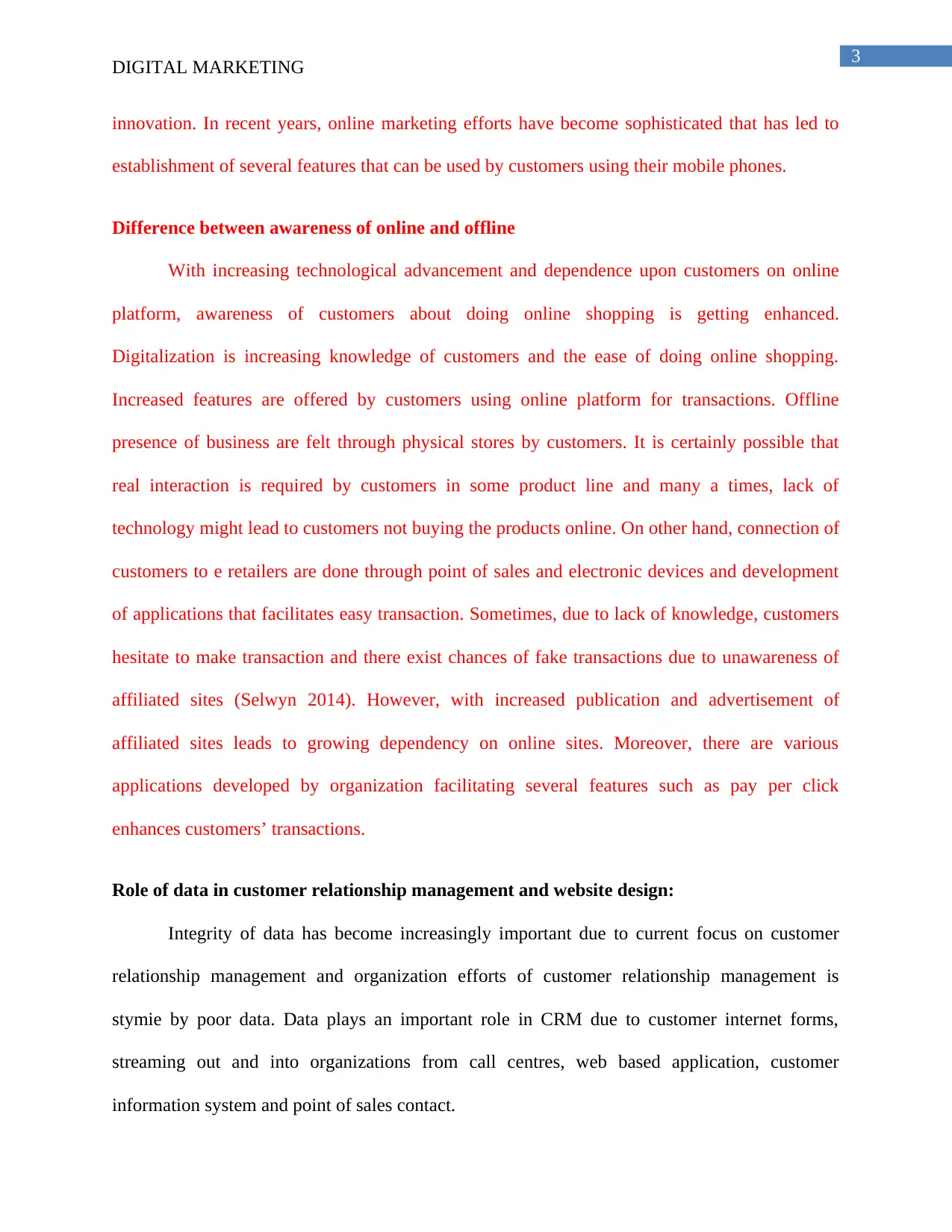
3
DIGITAL MARKETING
innovation. In recent years, online marketing efforts have become sophisticated that has led to
establishment of several features that can be used by customers using their mobile phones.
Difference between awareness of online and offline
With increasing technological advancement and dependence upon customers on online
platform, awareness of customers about doing online shopping is getting enhanced.
Digitalization is increasing knowledge of customers and the ease of doing online shopping.
Increased features are offered by customers using online platform for transactions. Offline
presence of business are felt through physical stores by customers. It is certainly possible that
real interaction is required by customers in some product line and many a times, lack of
technology might lead to customers not buying the products online. On other hand, connection of
customers to e retailers are done through point of sales and electronic devices and development
of applications that facilitates easy transaction. Sometimes, due to lack of knowledge, customers
hesitate to make transaction and there exist chances of fake transactions due to unawareness of
affiliated sites (Selwyn 2014). However, with increased publication and advertisement of
affiliated sites leads to growing dependency on online sites. Moreover, there are various
applications developed by organization facilitating several features such as pay per click
enhances customers’ transactions.
Role of data in customer relationship management and website design:
Integrity of data has become increasingly important due to current focus on customer
relationship management and organization efforts of customer relationship management is
stymie by poor data. Data plays an important role in CRM due to customer internet forms,
streaming out and into organizations from call centres, web based application, customer
information system and point of sales contact.
DIGITAL MARKETING
innovation. In recent years, online marketing efforts have become sophisticated that has led to
establishment of several features that can be used by customers using their mobile phones.
Difference between awareness of online and offline
With increasing technological advancement and dependence upon customers on online
platform, awareness of customers about doing online shopping is getting enhanced.
Digitalization is increasing knowledge of customers and the ease of doing online shopping.
Increased features are offered by customers using online platform for transactions. Offline
presence of business are felt through physical stores by customers. It is certainly possible that
real interaction is required by customers in some product line and many a times, lack of
technology might lead to customers not buying the products online. On other hand, connection of
customers to e retailers are done through point of sales and electronic devices and development
of applications that facilitates easy transaction. Sometimes, due to lack of knowledge, customers
hesitate to make transaction and there exist chances of fake transactions due to unawareness of
affiliated sites (Selwyn 2014). However, with increased publication and advertisement of
affiliated sites leads to growing dependency on online sites. Moreover, there are various
applications developed by organization facilitating several features such as pay per click
enhances customers’ transactions.
Role of data in customer relationship management and website design:
Integrity of data has become increasingly important due to current focus on customer
relationship management and organization efforts of customer relationship management is
stymie by poor data. Data plays an important role in CRM due to customer internet forms,
streaming out and into organizations from call centres, web based application, customer
information system and point of sales contact.
Paraphrase This Document
Need a fresh take? Get an instant paraphrase of this document with our AI Paraphraser
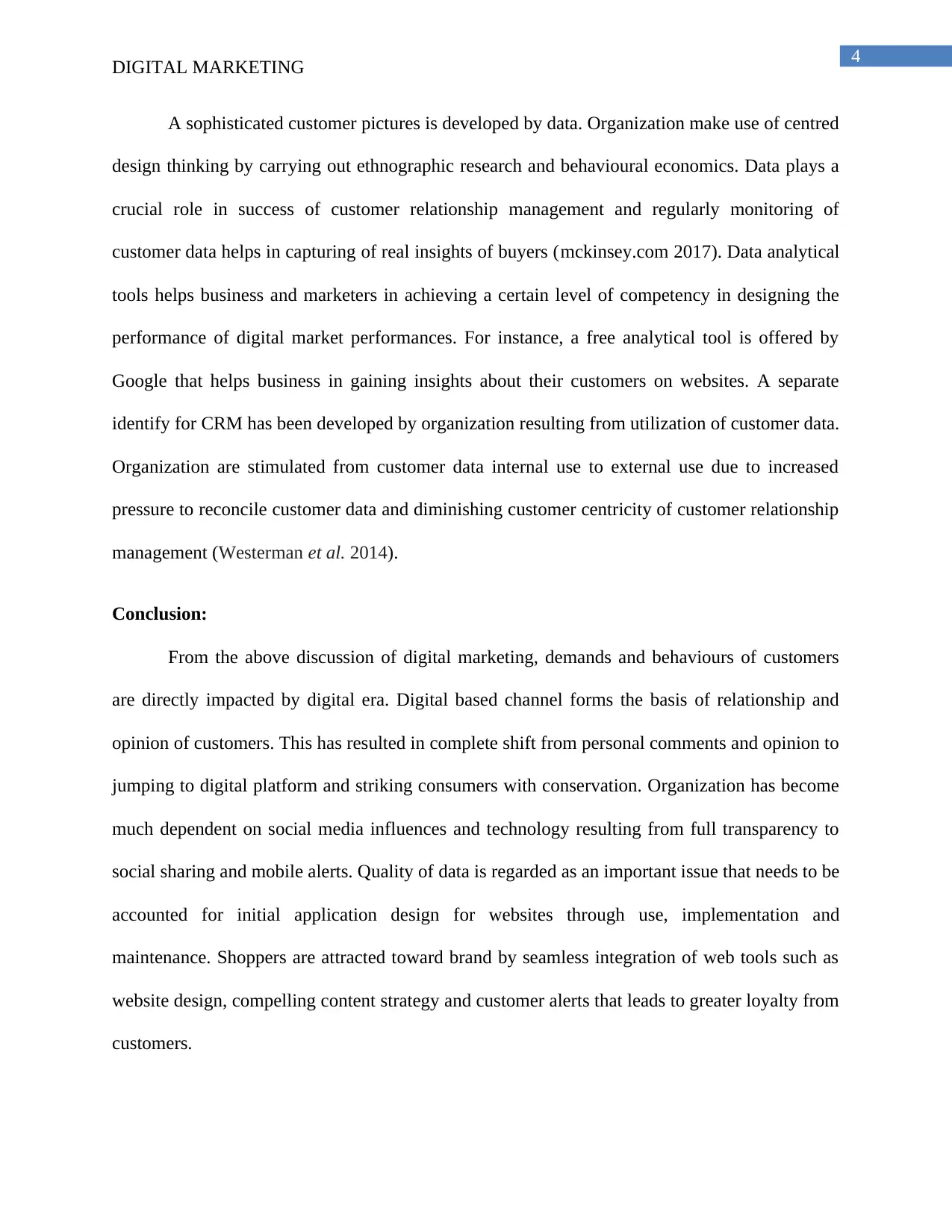
4
DIGITAL MARKETING
A sophisticated customer pictures is developed by data. Organization make use of centred
design thinking by carrying out ethnographic research and behavioural economics. Data plays a
crucial role in success of customer relationship management and regularly monitoring of
customer data helps in capturing of real insights of buyers (mckinsey.com 2017). Data analytical
tools helps business and marketers in achieving a certain level of competency in designing the
performance of digital market performances. For instance, a free analytical tool is offered by
Google that helps business in gaining insights about their customers on websites. A separate
identify for CRM has been developed by organization resulting from utilization of customer data.
Organization are stimulated from customer data internal use to external use due to increased
pressure to reconcile customer data and diminishing customer centricity of customer relationship
management (Westerman et al. 2014).
Conclusion:
From the above discussion of digital marketing, demands and behaviours of customers
are directly impacted by digital era. Digital based channel forms the basis of relationship and
opinion of customers. This has resulted in complete shift from personal comments and opinion to
jumping to digital platform and striking consumers with conservation. Organization has become
much dependent on social media influences and technology resulting from full transparency to
social sharing and mobile alerts. Quality of data is regarded as an important issue that needs to be
accounted for initial application design for websites through use, implementation and
maintenance. Shoppers are attracted toward brand by seamless integration of web tools such as
website design, compelling content strategy and customer alerts that leads to greater loyalty from
customers.
DIGITAL MARKETING
A sophisticated customer pictures is developed by data. Organization make use of centred
design thinking by carrying out ethnographic research and behavioural economics. Data plays a
crucial role in success of customer relationship management and regularly monitoring of
customer data helps in capturing of real insights of buyers (mckinsey.com 2017). Data analytical
tools helps business and marketers in achieving a certain level of competency in designing the
performance of digital market performances. For instance, a free analytical tool is offered by
Google that helps business in gaining insights about their customers on websites. A separate
identify for CRM has been developed by organization resulting from utilization of customer data.
Organization are stimulated from customer data internal use to external use due to increased
pressure to reconcile customer data and diminishing customer centricity of customer relationship
management (Westerman et al. 2014).
Conclusion:
From the above discussion of digital marketing, demands and behaviours of customers
are directly impacted by digital era. Digital based channel forms the basis of relationship and
opinion of customers. This has resulted in complete shift from personal comments and opinion to
jumping to digital platform and striking consumers with conservation. Organization has become
much dependent on social media influences and technology resulting from full transparency to
social sharing and mobile alerts. Quality of data is regarded as an important issue that needs to be
accounted for initial application design for websites through use, implementation and
maintenance. Shoppers are attracted toward brand by seamless integration of web tools such as
website design, compelling content strategy and customer alerts that leads to greater loyalty from
customers.
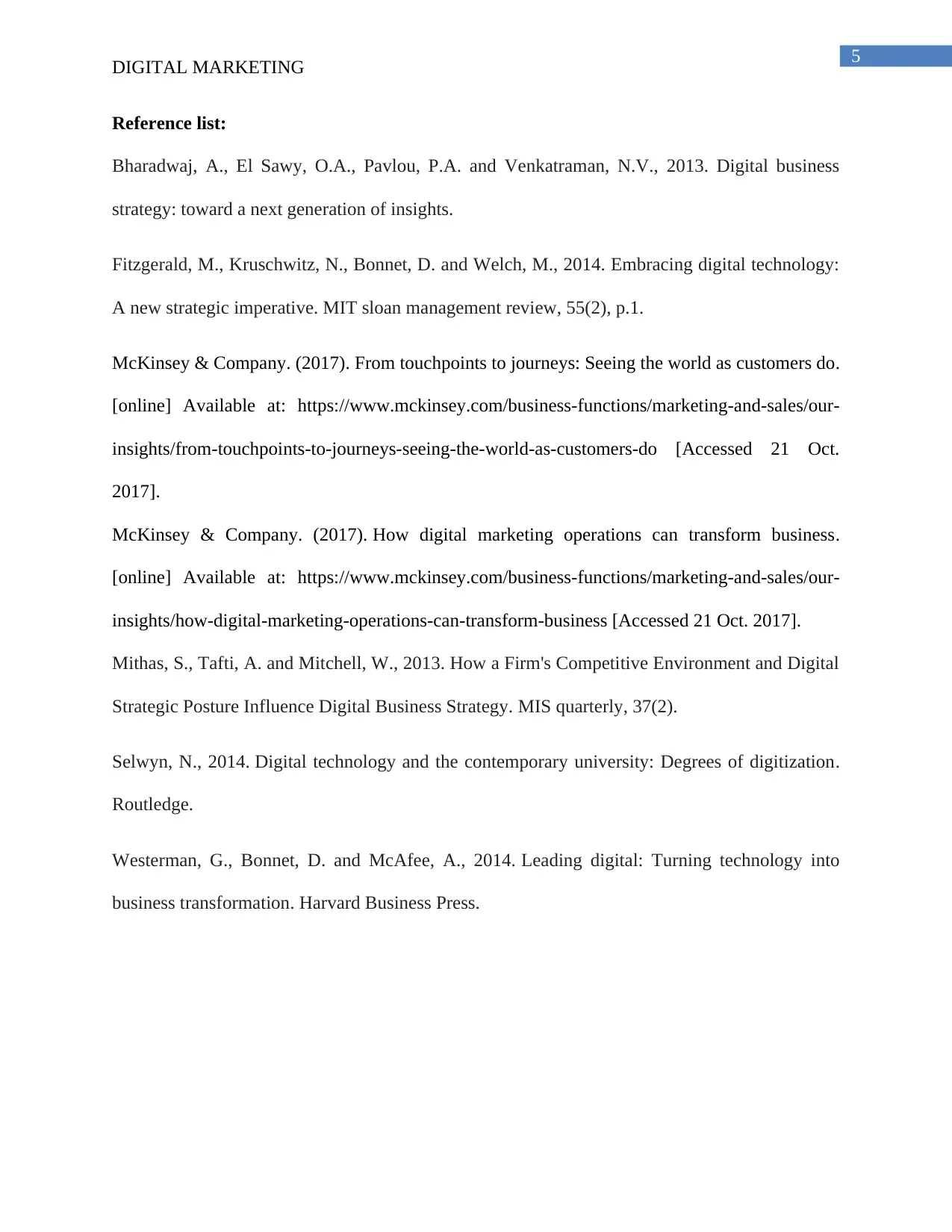
5
DIGITAL MARKETING
Reference list:
Bharadwaj, A., El Sawy, O.A., Pavlou, P.A. and Venkatraman, N.V., 2013. Digital business
strategy: toward a next generation of insights.
Fitzgerald, M., Kruschwitz, N., Bonnet, D. and Welch, M., 2014. Embracing digital technology:
A new strategic imperative. MIT sloan management review, 55(2), p.1.
McKinsey & Company. (2017). From touchpoints to journeys: Seeing the world as customers do.
[online] Available at: https://www.mckinsey.com/business-functions/marketing-and-sales/our-
insights/from-touchpoints-to-journeys-seeing-the-world-as-customers-do [Accessed 21 Oct.
2017].
McKinsey & Company. (2017). How digital marketing operations can transform business.
[online] Available at: https://www.mckinsey.com/business-functions/marketing-and-sales/our-
insights/how-digital-marketing-operations-can-transform-business [Accessed 21 Oct. 2017].
Mithas, S., Tafti, A. and Mitchell, W., 2013. How a Firm's Competitive Environment and Digital
Strategic Posture Influence Digital Business Strategy. MIS quarterly, 37(2).
Selwyn, N., 2014. Digital technology and the contemporary university: Degrees of digitization.
Routledge.
Westerman, G., Bonnet, D. and McAfee, A., 2014. Leading digital: Turning technology into
business transformation. Harvard Business Press.
DIGITAL MARKETING
Reference list:
Bharadwaj, A., El Sawy, O.A., Pavlou, P.A. and Venkatraman, N.V., 2013. Digital business
strategy: toward a next generation of insights.
Fitzgerald, M., Kruschwitz, N., Bonnet, D. and Welch, M., 2014. Embracing digital technology:
A new strategic imperative. MIT sloan management review, 55(2), p.1.
McKinsey & Company. (2017). From touchpoints to journeys: Seeing the world as customers do.
[online] Available at: https://www.mckinsey.com/business-functions/marketing-and-sales/our-
insights/from-touchpoints-to-journeys-seeing-the-world-as-customers-do [Accessed 21 Oct.
2017].
McKinsey & Company. (2017). How digital marketing operations can transform business.
[online] Available at: https://www.mckinsey.com/business-functions/marketing-and-sales/our-
insights/how-digital-marketing-operations-can-transform-business [Accessed 21 Oct. 2017].
Mithas, S., Tafti, A. and Mitchell, W., 2013. How a Firm's Competitive Environment and Digital
Strategic Posture Influence Digital Business Strategy. MIS quarterly, 37(2).
Selwyn, N., 2014. Digital technology and the contemporary university: Degrees of digitization.
Routledge.
Westerman, G., Bonnet, D. and McAfee, A., 2014. Leading digital: Turning technology into
business transformation. Harvard Business Press.
⊘ This is a preview!⊘
Do you want full access?
Subscribe today to unlock all pages.

Trusted by 1+ million students worldwide
1 out of 6
Related Documents
Your All-in-One AI-Powered Toolkit for Academic Success.
+13062052269
info@desklib.com
Available 24*7 on WhatsApp / Email
![[object Object]](/_next/static/media/star-bottom.7253800d.svg)
Unlock your academic potential
Copyright © 2020–2025 A2Z Services. All Rights Reserved. Developed and managed by ZUCOL.





